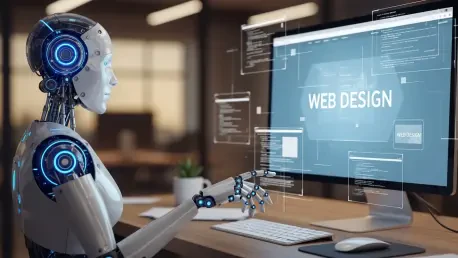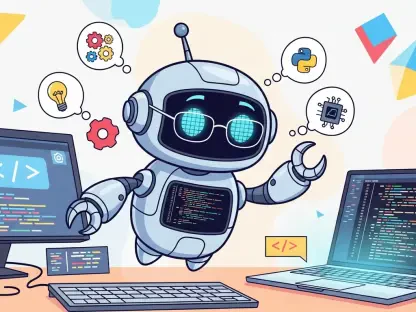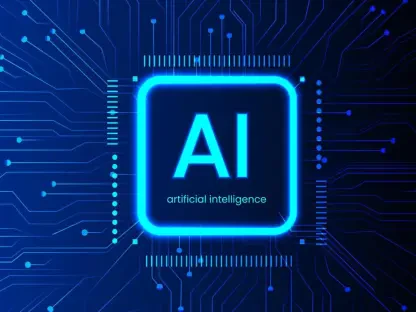The State of Web Design in the AI Era
The web design industry stands at a transformative juncture, where artificial intelligence is redefining how websites are created and launched, slashing timelines from months to mere minutes. This seismic shift is not just a technological upgrade but a response to the urgent demand for speed in a digital landscape where businesses must establish an online presence almost instantly to remain competitive. AI is dismantling the barriers of traditional design, offering tools that automate complex processes and empower both seasoned designers and novices to achieve professional results with unprecedented efficiency.
Historically, crafting a website involved labor-intensive tasks, often requiring weeks of manual coding, graphic design, and iterative feedback. Today, AI-driven platforms have turned this model on its head by automating repetitive elements such as layout generation and image editing, allowing creators to focus on strategic aspects like user experience and brand storytelling. This transition signifies a broader movement toward agility, where the ability to adapt quickly to market needs is paramount for success.
Key players like Wix ADI, Durable AI, and Adobe Firefly are leading the charge, providing solutions that cater to a spectrum of needs, from full-site creation to nuanced design enhancements. These tools are not only reshaping the toolkit of designers but also democratizing web creation for small businesses and entrepreneurs who lack technical expertise. The impact is profound, meeting modern expectations for rapid deployment while enabling scalability and customization at a fraction of the traditional cost.
Key Trends and Market Insights in AI-Driven Web Design
Emerging Trends Shaping the Industry
Automation has emerged as a cornerstone of AI in web design, taking over mundane tasks like responsive layout creation and component styling to free up human talent for innovation. This trend is complemented by the rise of data-driven design, where AI analyzes user behavior to recommend elements such as color schemes and typography that enhance engagement. Such capabilities ensure that designs are not just visually appealing but also functionally optimized for diverse audiences.
Another significant development is the integration of generative AI, which can produce unique visuals and layouts from simple text prompts, reducing dependency on stock imagery or lengthy design iterations. Personalization is also gaining traction, as consumers increasingly expect tailored web experiences that adapt to their preferences in real time. Additionally, there’s a growing focus on accessibility and sustainability, with AI tools ensuring compliance with inclusivity standards and optimizing sites for energy efficiency.
Consumer expectations are evolving alongside these advancements, with a clear demand for instant solutions that do not compromise on quality or individuality. Businesses are under pressure to deliver websites that reflect their brand identity swiftly, pushing the adoption of AI tools that promise customization without the wait. This shift is redefining success metrics in the industry, prioritizing speed and relevance over traditional benchmarks of design complexity.
Market Growth and Future Projections
The market for AI in web design is on a steep upward trajectory, with the generative AI sector projected to reach $109.37 billion by 2030. Meanwhile, the AI website builder market alone is expected to grow to $31.5 billion by 2033, reflecting a robust appetite for these technologies among businesses of all sizes. These figures underscore the transformative potential of AI as a core component of digital strategy.
Adoption rates are climbing steadily, with a significant portion of designers and companies integrating AI tools into their workflows to maintain a competitive edge. Performance indicators reveal that platforms offering rapid deployment and data-driven insights are seeing the highest uptake, particularly among small to medium enterprises seeking cost-effective solutions. This trend highlights a broader acceptance of AI as a reliable partner in creative processes.
Looking ahead, AI is poised to become indispensable for staying relevant in web design, with innovations likely to deepen integration over the next several years. From enhancing real-time adaptability to streamlining cross-platform consistency, the technology will continue to redefine industry standards. Businesses that embrace these tools early stand to gain a substantial advantage in a market increasingly defined by agility and precision.
Challenges in Adopting AI for Web Design
While the benefits of AI in web design are undeniable, several hurdles temper its widespread adoption. A primary concern is the risk of over-reliance on automation, which can result in generic outputs that fail to capture the unique essence of a brand. Without human oversight, AI-generated designs may lack the emotional resonance or cultural context that often define memorable digital experiences.
Quality control poses another challenge, as AI tools sometimes miss subtle nuances critical to brand identity or aesthetic depth. This inconsistency necessitates rigorous manual review to ensure alignment with client expectations and industry standards. Furthermore, the learning curve associated with mastering these tools can be steep for traditional designers unaccustomed to AI-driven workflows, creating a temporary barrier to seamless integration.
Ethical dilemmas also loom large, with biases in AI training data potentially leading to designs that exclude certain demographics or perpetuate stereotypes. Legal risks surrounding the copyright of AI-generated content add another layer of complexity, as ownership ambiguities could expose businesses to disputes. To mitigate these issues, a balanced approach is essential, combining AI assistance with human creativity to maintain originality while leveraging technological efficiency.
Regulatory and Ethical Considerations in AI Web Design
Navigating the regulatory landscape of AI in web design requires careful attention to unresolved issues like copyright uncertainties tied to machine-generated content. Data privacy is equally critical, as AI tools often rely on vast datasets that may include sensitive user information, raising concerns about compliance with global standards. These challenges highlight the need for clear legal frameworks to govern the use of such technologies.
Ensuring ethical integrity is paramount, particularly in avoiding biases that could compromise inclusivity in design outputs. Compliance with accessibility guidelines is non-negotiable, as AI must be programmed to prioritize equitable user experiences across diverse populations. Transparent practices in how AI tools are developed and deployed will be crucial to building trust among stakeholders and end-users alike.
As regulations evolve, they are likely to shape the development of AI tools, potentially imposing stricter guidelines on data usage and content ownership. Industry practices may need to adapt to these changes, emphasizing accountability in how AI is applied to web design. Staying ahead of these shifts will require proactive engagement with policymakers and advocacy for standards that support innovation without sacrificing ethical responsibility.
The Future of Web Design with AI
The trajectory of AI in web design points toward even greater personalization, where websites dynamically adjust to individual user preferences in real time. This capability will redefine engagement, making digital interactions more intuitive and relevant. As consumer behavior continues to demand bespoke experiences, AI’s role in delivering tailored solutions will only grow in significance.
Emerging technologies are also set to enhance sustainability, with AI optimizing designs for energy efficiency to meet the rising demand for environmentally conscious web solutions. Lightweight websites that reduce carbon footprints are becoming a priority, aligning with broader global goals for digital responsibility. This focus on green design could become a key differentiator in a crowded market.
Potential disruptors, such as breakthroughs in generative AI or unexpected shifts in user expectations, could further accelerate change within the industry. Global economic conditions and regional innovation hubs will also influence growth areas, shaping investment priorities and adoption patterns. Keeping pace with these dynamics will be essential for stakeholders aiming to capitalize on the next wave of AI-driven opportunities in web design.
Conclusion: Embracing AI for a Faster, Smarter Web Design Future
Reflecting on the insights gathered, it becomes evident that AI has reshaped web design by drastically cutting down project timelines and amplifying creative potential through data-driven approaches. This transformation marks a pivotal moment for the industry, as efficiency and innovation converge to meet escalating digital demands. The journey, however, reveals persistent challenges, from generic outputs to ethical quandaries, which demand thoughtful resolution.
Moving forward, stakeholders are encouraged to integrate AI strategically, viewing it as a collaborative ally rather than a standalone solution. Investing in training to blend human insight with technological prowess emerges as a critical step to ensure originality and brand alignment. Moreover, advocating for clearer regulatory guidelines on content ownership and data privacy stands out as a vital action to safeguard trust and inclusivity.
The horizon holds immense promise, with opportunities for growth in personalization and sustainable design beckoning industry players to innovate boldly. Prioritizing partnerships between AI developers and creative professionals is seen as a pathway to unlock untapped potential. This balanced approach paves the way for a future where web design not only thrives on speed but also on meaningful, impactful user connections.









